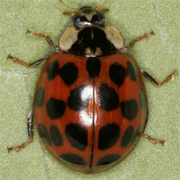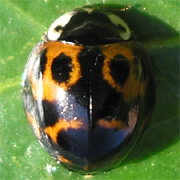
Zahlreiche Arten aus der Familie der Marienkäfer
(Coccinellidae) weisen innerhalb ein und derselben Art eine
außerordentliche Färbungsvariabilität auf, die vor allem dem Einsteiger
ihre Bestimmung deutlich erschwert.
Der Polymorphismus bei
zahlreichen Marienkäfer-Arten, allen voran Adalia bipunctata, ist
wissenschaftlich gut untersucht und die Ergebnisse in zahlreichen
Publikationen (siehe Literaturhinweise)
dokumentiert. Die Korrelation zwischen der Färbung und den
Überlebenschancen in der Überwinterung, dem Aktivitätsgrad bei
verschiedenen Temperaturen, dem Fortpflanzungserfolg, aber auch
industriell verursachter Umweltverschmutzung wurde von zahlreichen Autoren
untersucht und beschrieben.
Nachfolgend sollen den wichtigsten
Färbungsvarianten ausgewählter einheimischer Coccinellidae gezeigt werden,
um dem Einsteiger auch die Bestimmung "weniger typisch" gefärbter
Exemplare zu erleichtern. Bei dieser Gelegenheit gleich noch ein Aufruf
zur Mitarbeit: Wer gut aufgelöste Fotos (in dorsaler Ansicht) von
Färbungsvarianten hat, die hier noch nicht gezeigt sind, und sie für diese
Seite zur Verfügung stellen möchte, natürlich mit Copyright-Angabe, kann
sie mir gerne an an meine Email-Adresse schicken.
| Schnellübersicht | ||||||||||||||||
 |
 |
 |
 |
 |
 |
 |
 |
 |
 |
 |
 |
 |
 |
 |
 |
 |
 |
 |
 |
 |
 |
 |
 |
 |
 |
 |
 |
 |
 |
 |
 |
 | |
| Henosepilachna argus: | |||
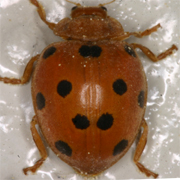
© Andreas Müller |
|||
| Subcoccinella vigintiquatuorpunctata: | |||

© Ingrid Altmann |

© Ingrid Altmann |

© CB |
|
| Chilocorus bipustulatus: | |||

© CB |
|||
| Chilocorus renipustulatus: | |||
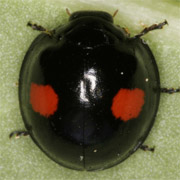
© CB |
|||
| Exochomus quadripustulatus: | |||

© Arp Kruithof |

© CB |

© CB |
|
| Aphidecta obliterata: | |||

© Ingrid Altmann |

© CB |

© CB |

© Ingrid Altmann |

© CB |
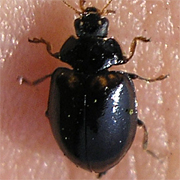
© Arp Kruithof |
||
| Hippodamia tredecimpunctata: | |||

© CB |

© CB |
||
| Hippodamia variegata: | |||

© CB |

© Andreas Müller |
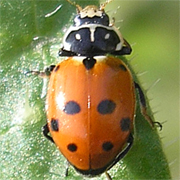
© Arp Kruithof |

© CB |

© CB |

© Arp Kruithof |
||
| Hippodamia notata: | |||
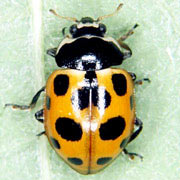
© CB |
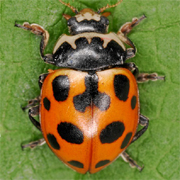
© Ingrid Altmann |
||
| Hippodamia undecimnotata: | |||

© CB |
|||
| Anisosticta novemdecimpunctata: | |||

© CB |
|||
| Tytthaspis sedecimpunctata: | |||

© CB |

© Ingrid Altmann |
||
| Adalia conglomerata: | |||

© CB |

© CB |

© CB |
|
| Adalia decempunctata: | |||

© Ingrid Altmann |
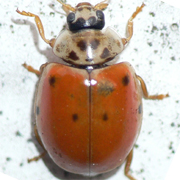
© Jürgen Peters |

© CB |
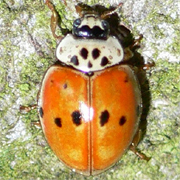
© Jürgen Peters |
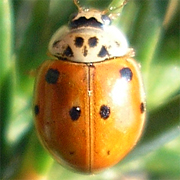
© Arp Kruithof |

© CB |

© Ingrid Altmann |

© Jürgen Peters |
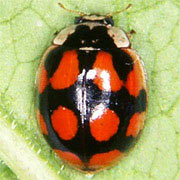
© CB |
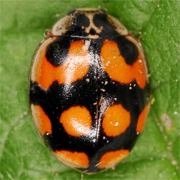
© Ingrid Altmann |
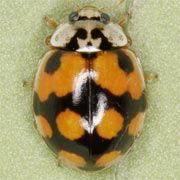
© CB |
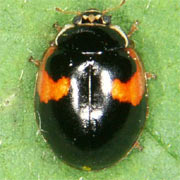
© CB |
| Adalia bipunctata: | |||

© CB |
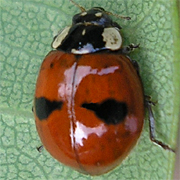
© Arp Kruithof |

© Arp Kruithof |

© CB |

© Ingrid Altmann |
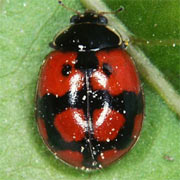
© CB |
||
| Coccinella hieroglyphica: | |||

© CB |

© Ingrid Altmann |
||
| Coccinella septempunctata: | |||

© CB |

© Jürgen Peters |

© Jürgen Peters |
|
| Coccinella magnifica: | |||

© CB |
|||
| Coccinella quinquepunctata: | |||

© CB |
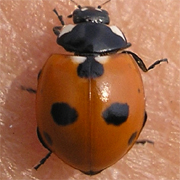
© Arp Kruithof |
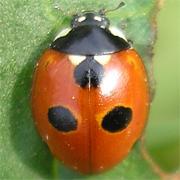
© Arp Kruithof |
|
| Coccinella undecimpunctata: | |||

© CB |
|||
| Coccinula quatuordecimpustulata: | |||

© CB |
|||
| Oenopia conglobata: | |||

© Arp Kruithof |
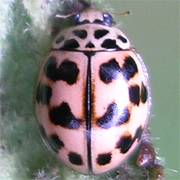
© Arp Kruithof |
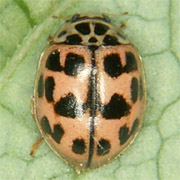
© CB |

© CB |
| Harmonia quadripunctata: | |||
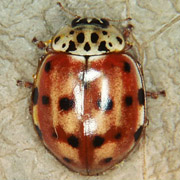
© CB |

© CB |

© Frank Dickert |

© Arp Kruithof |
| Myrrha octodecimguttata: | |||
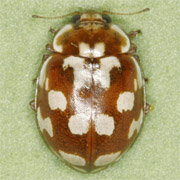
© CB |
|||
| Sospita vigintiguttata: | |||
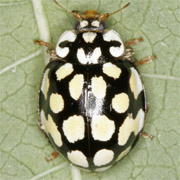
© CB |
|||
| Calvia decemguttata: | |||

© CB |
|||
| Calvia quatuordecimguttata: | |||

© CB |

© Kirsten Eta |
||
| Propylea quatuordecimpunctata: | |||

© CB |

© Ingrid Altmann |

© CB |

© Ingrid Altmann |

© Arp Kruithof |

© Arp Kruithof |

© Jürgen Peters |

© Ingrid Altmann |

© CB |

© Kirsten Eta |
||
| Myzia oblongoguttata: | |||

© CB |

© Angie Opitz |
||
| Anatis ocellata: | |||
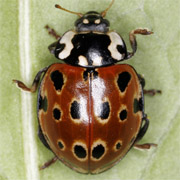
© CB |

© Arp Kruithof |

© Arp Kruithof |
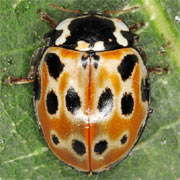
© Ingrid Altmann |

© Ingrid Altmann |
|||
| Halyzia sedecimguttata: | |||

© CB |

© Arp Kruithof |
||
| Psyllobora vigintiduopunctata: | |||
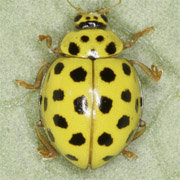
© CB |
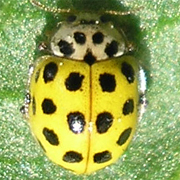
© Arp Kruithof |
||
Literaturhinweise:
- Zur Analyse des Polymorphismus bei Adalia bipunctata L.
N. W. Timofeeff-Ressovsky, Biol. Zbl. 1940, 60 (3-4), 130-137. - Is polymorphism in two-spot ladybird an example of non-industrial
melanism?
B. R. Benahm, D. Lonsdale, J. Muggleton, Nature 1974, 249, 179-180. - Melanism in Adalia bipunctata L. (Col., Coccinellidae) and its
Relationship to Atmospheric Pollution
J. Muggleton, D. Lonsdale, B. R. Benham, The Journal of Applied Ecology 1975, 12 (2), 451-464. - Polymorphism in the Two-Spot Ladybird Adalia bipunctata in
Western Norway
S.-A. Bengtson, R. Hagen, Oikos 1975, 26 (3), 328-331. - On polymorphism in elytral coloration pattern in Coelophora
quadrivittata (Coleoptera, Coccinellidae)
J. Chazeau, Entomologia Experimentalis et Applicata 1980, 27 (2), 194-198. (Externer Link zum Dokument )
)
- Ecological Studies on the Polymorphic Ladybird Adalia bipunctata
in the Netherlands. II. Population Dynamics, Differential Timing of
Reproduction and Thermal Melanism
P. Brakefield, The Journal of Animal Ecology 1984, 53 (3), 775-790. (Externer Link zum Dokument )
)
- Selection along Clines in the Ladybird Adalia bipunctata in the
Netherlands: A general mating Advantage to Melanics and its
Consequences
P. Brakefield, Heredity 1984, 53 (1), 37-49. (Externer Link zum Dokument )
)
- Polymorphic Mullerian mimicry and interactions with thermal
melanism in ladybirds and a soldier beetle: a hypothesis
P. Brakefield, Biol. J. Linn. Soc. 1985, 26, 243-267. - Differential winter mortality and seasonal selection in the
polymorphic ladybird Adalia bipunctata (L) in the Netherlands
P. Brakefield, Biological Journal of the Linnean Society 1985, 24 (2), 189-206. (Externer Link zum Dokument [ab. S. 45])
[ab. S. 45])
- Why big species of ladybird beetles are not melanic?
L. A. Stewart, F. G. Dixon, Funct. Ecol. 1989, 3, 165-171. - Seasonal variation in elytral colour polymorphism in Harmonia
axyridis (the ladybird beetle): the role of non-random mating
N. Osawa, T. Nishida, Heredity 1992, 69, 297-307. - Differences in thermal balance, body temperature and activity
between non-melanic and melanic two-spot ladybird beetles (Adalia
bipunctata) under controlled conditions
P. Jong, S. Gussekloo, P. Brakefield, J. Exp. Biol. 1996, 199 (12), 2655-2666. (Externer Link zum Dokument )
)
- Does thermal melanism maintain melanic polymorphism in the
two-spot ladybird, Adalia bipunctata (Coleoptera:
Coccinellidae)?
M. Majerus, I. Zakharov, Zh. Obshch. Biol. 2000, 61 (4), 381-392. - Temporal stability of morph frequency in central European
populations of Adalia bipunctata and A. decempunctata (Coleoptera:
Coccinellidae)
A. Honek, Z. Martiková, S. Pekár, European Journal of Entomology 2005, 102 (3), 437-442.





